
About UsThe Numismatic Bibliomania Society is a non-profit organization promoting numismatic literature. For more information please see our web site at coinbooks.org SubscriptionsThose wishing to become new E-Sylum subscribers (or wishing to Unsubscribe) can go to the following web page link MembershipThere is a membership application available on the web site Membership Application To join, print the application and return it with your check to the address printed on the application. Membership is only $15 to addresses in the U.S., $20 for First Class mail, and $25 elsewhere. For those without web access, write to: David M. Sundman, Secretary/TreasurerNumismatic Bibliomania
Society AsylumFor Asylum mailing address changes and other membership questions, contact David at this email address: dsundman@LittletonCoin.com SubmissionsTo submit items for publication in The E-Sylum, just Reply to this message, or write to the Editor at this address: whomren@coinlibrary.com
BUY THE BOOK BEFORE THE COINYou won't regret it! |
- WAYNE'S WORDS: THE E-SYLUM FEBRUARY 6, 2011
- BREAKTHROUGH FOR AOL E-SYLUM READERS?
- WATER DAMAGE AT THE AMERICAN NUMISMATIC ASSOCIATION LIBRARY
- LAKE BOOKS' 106TH MAIL-BID SALE CLOSES FEBRUARY 8, 2011
- SKLOW MAIL BID SALE NO. 12 HIGHLIGHTS
- SIX NEW BOOKS NOW AVAILABLE FROM MONETA PUBLICATIONS
- BOOK REVIEW: FOUR DUCAT COINS WITH BULGARIAN COUNTERSTAMPS
- BOOK REVIEW: THE ART OF MEDAL ENGRAVING BY ELIZABETH M. HARRIS
- BOOK REVIEW: MONEYMAKERS: ADVENTURES OF THREE NOTORIOUS COUNTERFEITERS
- JOHNSON ACQUIRES SCHENKMAN DATA ON AMERICAN DIESINKERS AND ENGRAVERS
- THE U.S. MINT LAUNCHES YOUTUBE CHANNEL WITH MERCANTI VIDEO
- MORE ON NUMISMATIC TERMINOLOGY
- THE LASSER COLLECTION AT COLONIAL WILLIAMSBURG
- MORE ON THE NUMISMATIC MUSEUM OF ATHENS
- MORE ON NUMISMATIC E-BOOKS AND OUTREACH TO YOUNGER COLLECTORS
- QUERY: EARLIEST "HOBO NICKEL" USE AND ILLUSTRATION SOUGHT
- NOTES FROM E-SYLUM READERS: FEBRUARY 6, 2011
- NUMISMATIC BOOK MUTILATION AT THE LIBRARY OF CONGRESS
- LOOTING IN EGYPT: WHAT NEXT?
- QUERY: 1872 COIN HOARD FIND SOUGHT
- SPAIN'S NEW 2011 TWO-EURO COIN
- TWO ALASKAN MEDALS IN CERAMIC OR PORCELAIN
- MANLEY SELLS MENTOR'S ORANGE COUNTY NATIONAL BANK NOTES
- FAKE 1804 DOLLAR DROPPED IN SALVATION ARMY KETTLE
- FEATURED WEB PAGE: TEACHING COINS
WAYNE'S WORDS: THE E-SYLUM FEBRUARY 6, 2011

Among our new subscribers this week is Christopher L. Cobert. Welcome aboard! We now have 1,400 email subscribers, plus 116 followers on Facebook, including Abhay Bhalerao.
This week we open with an update on our AOL problem, and a report on a water damage problem at the ANA library. Next up are reminders from dealers Fred Lake and David Sklow, and an announcement of six new Moneta publications. Book reviews this week cover three old and new numismatic works.
Other topics include the new U.S. Mint YouTube channel, the Lasser Collection at Colonial Williamsburg, e-books, and looting in Egypt. To learn more about Saxton's 1837 medal-ruling machine, Schenkman's research on American Diesinkers and Engravers, book mutilation, and S. G. Onions' Teaching Coins, read on. Have a great week, everyone!
Wayne Homren
Numismatic Bibliomania Society
BREAKTHROUGH FOR AOL E-SYLUM READERS?
As noted in several earlier E-Sylum articles, many of our AOL subscribers have been having difficulty accessing their weekly E-Sylum email. AOL is notorious for being difficult to work with, and several weeks ago they made a change that started causing these problems.
It's taken a while, but we may finally have a breakthrough. Engineers at our mailing list hosting company Binhost have been looking into it, and this week we ran some tests of a possible fix. Binhost tech Shuli was the latest to look into it, and she discovered that AOL had gotten more strict on the details of email header information. At my request she set up a test mailing list, and I recruited some volunteers from among the folks who had reported trouble. She tweaked our header information and we ran the test. Here's what folks had to say.
Len Harsel writes:
Whatever she did seems to be working (at least for now).
Ginger Rapsus writes:
Yes! I was able to open and read The E-Sylum for the first time in months.
Thanks also to Alan V. Weinberg, Steve Tompkins, and Joe Boling, who also reported positive results. Following this test we feel confident enough to try it with the entire mailing list - today's issue is being sent out with the revised version of the header. Most readers should see no difference, but AOL readers who've previously had problems may be able to open and read their email again. Thanks for bearing with us while we researched the problem (with zero cooperation from AOL).
If an AOL readers are having the separate problem of The E-Sylum landing in their spam folder, an E-Sylum reader offers this advice:
For the spam folder issue... there have been a lot of changes around mail and mail settings. If they go to Keyword: Spam, or http://daol.aol.com/security/spam , there's a button there to go to the Spam Controls. Once there, make sure the email address and domain that the Esylum comes from is not listed in the "Block mail from these users" area.
If the mail has ever landed in Spam, it's probably listed in there so it will be delivered to the Spam folder every time until it's removed from the Block list. After taking it out of the Block list (or just making sure it's not there), lightening up on the Spam threshold in the same page (going from Medium to Low, for instance) should also help alleviate some of the problems.
To read the earlier E-Sylum article, see: THE AOL SAGA CONTINUES (www.coinbooks.org/esylum_v14n05a02.html)
WATER DAMAGE AT THE AMERICAN NUMISMATIC ASSOCIATION LIBRARY
Pete Smith passed along a note received Thursday from Amanda Harvey, Assistant Library Manager at the American Numismatic Association:
This is an automated message designed to let you know that the ANA Library is closed because of a water pipe burst. I will respond to your request as soon as I am able.
The Dwight N. Manley Numismatic Library is billed as the largest circulating numismatic library in the world, and is one of the leading repositories of numismatic literature in the U.S. Water damage is a bibliophile's nightmare, so on Friday I called Library Director Ryanne Scott to learn what happened.
First, the good news: it seems that the damage was light and limited to duplicates and easily replaceable items. Here's what happened. The burst pipe was part of the building's boiler system. Ironically, the system had been scheduled for regular maintenance just days before, but the work had to be postponed because of the cold winter weather brought by the nationwide storm system. The ANA had actually been closed for two days because of the weather. Had the pipe burst when the building was unoccupied, the damage would have been far worse.
The pipe was in the basement, near where the library's periodicals are shelved. A staffer went down to the basement to get something to fill a member's library order and heard the rushing water just as the pipe burst. Facilities Manager Gerry Vanderfin was able to shut off the flow within two minutes.
Library staff is currently inventorying the damage in order to file an insurance claim. The largest item damaged was a set of the ANA's own publication The Numismatist. This was not the library's only set - it was a 3rd duplicate copy.
Numismatists everywhere can breathe a sigh of relief - thanks to some good fortune and the quick work of ANA staff the damage was limited, and hopefully with insurance proceeds the damaged works will ultimately be replaced.
LAKE BOOKS' 106TH MAIL-BID SALE CLOSES FEBRUARY 8, 2011
This is a reminder that Lake Books' 106th mail-bid sale of numismatic literature closes on Tuesday, February 8, 2011 at 5:00 PM (EST). The sale may be viewed at http://www.lakebooks.com/current.html and bids can be place via email, fax, or telephone until that time. It is wise to bid early as tie bids are won by the earliest bid received. The 507-lot sale includes reference material from United States and European auction houses along with books on nearly every facet of the numismatic experience and some interesting exonumia writings.
Good Luck with your bidding ! Fred
Lake Books
6822 22nd Ave. N.
St. Petersburg, FL 33710
727-343-8055 Fax 727-345-3750
SKLOW MAIL BID SALE NO. 12 HIGHLIGHTS
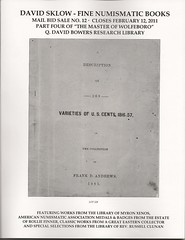 A reminder that David Sklow-Fine Numismatic Books Mail Bid Sale # 12 Closes Saturday February 12, 2011 at 8pm Mountain Time
A reminder that David Sklow-Fine Numismatic Books Mail Bid Sale # 12 Closes Saturday February 12, 2011 at 8pm Mountain Time
One Week left to bid! Do not miss out!
SOME HIGHLIGHTS OF THE SALE
- Mail Bid Auction Sale # 12-Closing February 12, 2011 is something very special! Part IV of the Q. David Bowers Research and Source Library will lead the sale; QDB's many works on United States History, Biographies, Dictionaries and other reference works as well as several letters from Walter Breen
- The American Museum Volumes 1788-1792
- Bound Numismatic Scrapbooks the "War" years 1942-1948
- Several seldom offered works by Andrew McFarland Davis
- A nearly complete run of the Colonial Newsletter
- Roman Imperial Coinage Volumes I-IX
- Long run of J.C. Morgenthau catalogs [Wayte Raymond & J.G. Macallister]
- Deluxe Numbered Morocco edition of California Pioneer Fractional Gold by Breen & Gillio Ex: Armand Champa.
- Limited edition numbered set of catalogs of the Norweb Collection of English Coins sales, by Spink.
- Kam Ahwash's personal annotated [Liberty Seated Coinage]copy of the 1975 ANA sale catalog.
- The original printing plates for Spanish Orders of Chivalry and Decorations by Gillingham.
- A very special consignment the "Medals and Badges" of the American Numismatic Association from the estate of the late Rollie Finner; many rarities and many seldom if ever seen pieces a collection put together from over fifty years of collecting!
- An offering of over three thousand photographs of individual United States Large Cents 1793-1814 in full color used by Bill Noyes in his great books.
- Some special offerings from the Rev. Russell Clunan Library.
- A long run of Chapman Auction catalogs.
- Catalog runs of many small auction companies 1930-1969
- Super Deluxe editions of the Garrett, Eliasberg and Brand auction catalogs, numbered very limited editions.
- Deluxe edition of Roger Cohen Half Cent Collection Catalog, specially inscribed to Jules Reiver.
- Brass Checks and Red Lights – Deluxe edition by Mazzulla
- Very Rare First edition 1881 Andrews 1816-1857 United States Large Cents
- Second edition 1883 Andrews 1816-1857 United States Large Cents.
- Clapp's work on 1798-99 Large Cents serial no. 33.
- Newcomb's 1801-02-03 Large Cent work, with scarce supplemental plate.
- Chapman's 1794 Large Cents 1926 second edition.
- Crosby's Cents of 1793 original 1897 edition with plates..
- Frossard and Hays United States Cents 1794 with plates, 1910 edition.
- Gilbert and Elder United States Cents of 1796 bound 1909 original with plates.
- Frossard and Hays United States Cents of 1794 original bound 1893 edition with plates.
- The Numismatist 1894-1936 bound volumes.
- The Numismatist 1888-1893 scarce reprint volume.
- Special Deluxe Catalog of the Buddy Ebsen Collection, with 50 photographic plates, inscribed and autographed by Buddy!
- Long run of Superior Galleries Deluxe, Super Deluxe and Special Edition Catalogs
- Long run of the Gobrecht Journal
- A Special Full Leather very limited edition presentation inscribed copy of American Half Cents, by Roger Cohen.
- A wonderful offering of Red Books!
- Very Rare work by N. Neil Harris - ANA Badges & Medals, limited publication 1968 original spiral bound as issued
Bidders may enter bids by mail, telephone, email or fax. The sale closes at 8pm mountain time, February 12, 2011, however, any bids left on our answering machines or sent by email or fax on or before midnight on closing day will be accepted.
Catalog is viewable on our web site
If you have already submitted your bids, consider this an additional Thank You!
David Sklow-Fine Numismatic Books
P.O. Box 6321
Colorado Springs, CO 80934
PH: 719-302-5686
FAX: 719-302-4933
EMAIL: numismaticbooks@aol.com
WEB: FineNumismaticBooks.com
SIX NEW BOOKS NOW AVAILABLE FROM MONETA PUBLICATIONS
Six new books now available in January 2011 in the Moneta publications www.moneta.be (see "nouveautes")
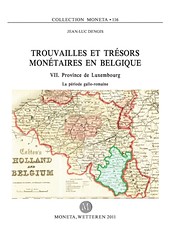
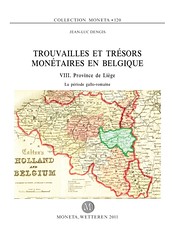
J.-L. Dengis, Trouvailles et trésors monétaires en Belgique
Vol. 116, VII. Province de Luxembourg, Les monnaies romaines.
Vol. 120, VIII. Province de Ličge, Les monnaies romaines,
Documents and Studies on 19th c. Monetary History
Vol. 117, International Monetary Conferences, Republication of Report of the International Conference (London, 1868),
Vol. 118, International Monetary Conferences, Republication of Report of the Royal Commission on International Coinage (London, 1868),
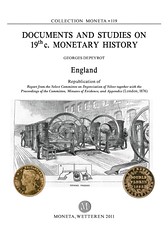
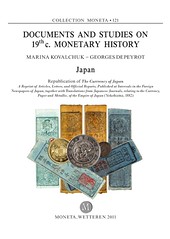
Vol. 119, England, Republication of Report from the Select Committee on Depreciation of Silver (London, 1876)
Vol. 121, Japan, Republication of The Currency of Japan, (Yokohama, 1882)
To visit the Moneta web site, see: www.moneta.be
BOOK REVIEW: FOUR DUCAT COINS WITH BULGARIAN COUNTERSTAMPS
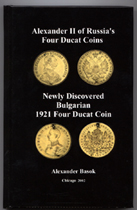 Complete Catalog of Four Ducat Coins with Bulgarian Counterstamps under the names of Alexander II of Russia, Franz Joseph of Austria, Ferdinand I of Bulgaria, Boris III of Bulgaria by Alexander Basok (Chicago, USA, 2002. English text. Hardcover, 135 pages, 50 color plates. $45 + $5 s&h).
Complete Catalog of Four Ducat Coins with Bulgarian Counterstamps under the names of Alexander II of Russia, Franz Joseph of Austria, Ferdinand I of Bulgaria, Boris III of Bulgaria by Alexander Basok (Chicago, USA, 2002. English text. Hardcover, 135 pages, 50 color plates. $45 + $5 s&h).
This is one of the many dusty corners of numismatics. The subject matter is tangential to a popular coin. It is easy to find Austria's thin, large diameter gold four ducat restrikes of 0.44 oz., all dated 1915. This book catalogues an intriguing variant, restrikes with the Bulgarian coat of arms.
They come from over a dozen sources, exhibiting a wide range of skill in craftsmanship from exquisite to crude. Basok's taxonomy parses them into broader and finer groups. The two rubrics are easy enough: Kovnica AG in Belgrade produced the finest examples; then there are all the others. Basok sorts them into four types by monarch. These are subdivided into 50 varieties, all illustrated and described.
This book may be rarer than the coins. The ANA has it in their library (call number JM63.B3), but the ANS does not, though the DONUM catalog lists Alexander Basok's articles for The Celator and the Journal of the Russian Numismatic Society. Basok's sales site offers it among his inventory of literature, of course, as does Münzgalerie München. Short of that, you have to meet him in person, as I did at the MSNS Thanksgiving 2010 convention.
BOOK REVIEW: THE ART OF MEDAL ENGRAVING BY ELIZABETH M. HARRIS
Regarding Dick Johnson's earlier article on NUMISMATIC VOCABULARY: ANAGLYPTOGRAPHY, David Gladfelter writes:
Readers might be interested in Elizabeth M. Harris's book on this topic, The Art of Medal Engraving (Newtown, Pa., Bird & Bull Press, 1991). It includes an actual plate from Collas's Tresor (my copy has plate XII) and, as an appendix, Nolte's 1837 "Memorial of Facts Connected with the History of Medallic Engraving, and the Process of M. Collas" accompanied by an engraved plate titled "Answer to Mr. Bate's Challenge" (inviting Collas to copy a medal of Ariadne without distortion).
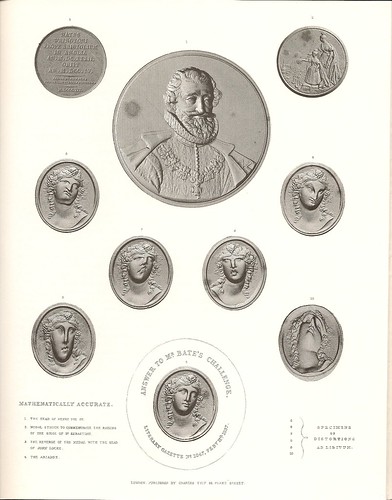
Nolte's plate has the Ariadne medal and four others correctly engraved, together with six deliberate and hilarious distortions presented by Nolte ostensibly to prove that the results of his company's process were "quite satisfactory to every beholder whose ideas have not been disturbed by a quibble about accuracy".
Harris cites Richard Doty that medal engravings did not die out in the 19th century but continued to be used well into the 20th as a security device on bank notes of about 25 countries. The undistorted Ariadne medal-ruling image or a close copy of it has been used on quite a few bank notes, some of which are in my collection.
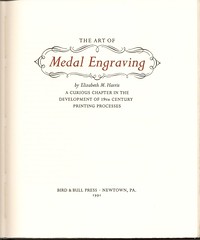 David kindly lent me a copy of the book to review. It's a 1991 Bird & Bull Press production. It's beautifully done, as are all B&B works. "Two hundred-thirty copies of this book have been printed on Johannot mouldmade paper at the Bird & Bull Press in April 1991. The text was composed in Perpetua type by W. Thomas Taylor and the book was bound by Campbell-Logan Bindery."
David kindly lent me a copy of the book to review. It's a 1991 Bird & Bull Press production. It's beautifully done, as are all B&B works. "Two hundred-thirty copies of this book have been printed on Johannot mouldmade paper at the Bird & Bull Press in April 1991. The text was composed in Perpetua type by W. Thomas Taylor and the book was bound by Campbell-Logan Bindery."
There are 37 pages of text plus the plates David described. The Nolte appendix is an additional 12 pages. The 39 NOTES (pages 36-37) document the author's sources, ranging from histories of pantographs and pantographic copying process, to the writings of Charles Babbage, Jacob Eckfeldt and William DuBois. Note 6 provides a short biography of Joseph Saxton, one of my favorites among early U.S. Mint employees.
B&B owner Henry Morris described the genesis of the book in his two-page Foreword. Here are some excerpts:
Medal engraving was one of the lesser-known 19th-century graphic processes, but I think one of the most interesting. The technique produced an attractive printed image of unique character that generated wonder and admiration in 19th-century audiences, and deserves to be better known to those today who are interested in the history of the Book.
I first learned of medal engraving and its use in book illustration from Elizabeth M. Harris' 1968 article Experimental Graphic Processes in England 1800-1859, which appeared in the Journal of the Printing Historical Society of that year.
When I found that there were some broken copies of Collas' Tresor de numismatique available with many of the medal-engraved plates intact, I began to consider printing this book."
Morris goes to great lengths to state that no books were harmed in the course of making this one: "I wish to stress that the Collas plates included here were taken from copies that were incomplete, with missing text and plate pages, and in generally falling-apart and broken condition. I would respectfully remind the reader that I am a maker of, and not a destroyer of books."
It should come as little surprise to longtime NBS members that numismatic literature dealer George Kolbe was involved with the project, providing the Collas plates and original copies of other numismatic books for illustrations. Kolbe and Morris have been involved in a number of publishing projects (which would make for a great Asylum article someday).
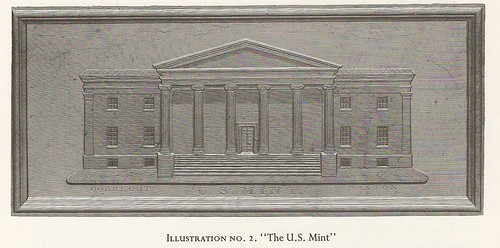
Numismatic personalities abound in this account, including Benedetto Pistrucci, William Wyon, Jacob Perkins, Christian Gobrecht (for his 1817 medal-engraving machine) and the above-mentioned Joseph Saxton (for his ca. 1837 medal-ruling machine). Both men had a hand in the illustration of the Second U.S. Mint (shown above) in Eckfeldt and Du Bios' Manual of Gold and Silver Coins, which was based on a daguerreotype photo by Saxton. I have multiple examples of this book in my library - I like this image as one of the earliest examples of the use of photography in printing. Actually, the author notes that it "represents a combination of the three most scientific advances in graphic arts up to that time. Moreover, it could well be considered a "missing link" in the evolution of the methods used to make pictures."
The book offers a fascinating history of this important aspect of printing history, offering glimpses of the personalities involved, the courtroom and business battles over competing technologies, as well as a peek at many of the technical nuances involved. Highly recommended reading for the numismatist as well as the bibliophile - stories like these are what make the history of our hobby come alive. Many thanks to David for sharing this book with us.
To read the earlier E-Sylum article, see: NUMISMATIC VOCABULARY: ANAGLYPTOGRAPHY (www.coinbooks.org/esylum_v13n48a12.html)
BOOK REVIEW: MONEYMAKERS: ADVENTURES OF THREE NOTORIOUS COUNTERFEITERS
Regarding the item about the new book by Ben Tarnoff, "The Wicked Lives and Surprising Adventures of Three Notorious Counterfeiters", Bob Neale of North Carolina writes:
I recently gave a talk to our Senior Men's Club here in Wilmington. Titled "The Fake Makers," I started with William Chaloner and the hanging tree in 1690s London and Sir Issac Newton's role in that; introduction to the counterfeiting of paper money; then Upham and Hilton, of course; and the Lincoln body snatching operation.
I wonder which three persons Mr. Tarnoff wrote about? I didn't have time to include another two fun personalities in my talk: Oliver Thompkins and his counterfeit house, and Canadian Aimee Dupont's setup and entrapment by two U.S. Secret Service agents in the early 1900s.
There is often some really fun history connected with folks who play by their own rules in life. When it comes to great stories, one might truly say that counterfeiting is the real thing.
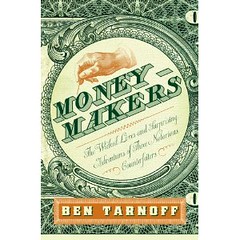 Mr. Tarnoff, who graduated from Harvard in 2007 and has worked at Lapham's Quarterly, focuses on the lives of three counterfeiters who lived in the 18th and 19th centuries. Taken together, he writes, these three biographies "tell the story of a country coming of age — from a patchwork of largely self-governing colonies to a loosely assembled union of states and, finally, to a single nation under firm federal control."
Mr. Tarnoff, who graduated from Harvard in 2007 and has worked at Lapham's Quarterly, focuses on the lives of three counterfeiters who lived in the 18th and 19th centuries. Taken together, he writes, these three biographies "tell the story of a country coming of age — from a patchwork of largely self-governing colonies to a loosely assembled union of states and, finally, to a single nation under firm federal control."
The first subject of this rollicking good read is Owen Sullivan, an Irish immigrant who was born around 1720 and originally was a silversmith in Boston. In the seven years he was a counterfeiter, he built a loosely organized team called the Dover Money Club.
Like his partners, Sullivan was behind bars several times in the course of his career. Until his final arrest, however, these encounters with the law were small detours on an entrepreneurial journey in pre-industrial crime. When he was hanged in New York City in 1756, he claimed to have forged more than £25,000 worth of colonial money.
By the early 1800s, paper money in the form of individual bank notes had returned in force. And with it came enterprising counterfeiters like David Lewis (1788-1820), who worked the rural counties of southwestern Pennsylvania forging notes and stirring up populist rage against financial elites.
Finally, Mr. Tarnoff recounts the story of Samuel Upham (1819-1885), a Philadelphia shopkeeper who, in 1862, began printing $5 Confederate notes, which he sold as "mementos of the Rebellion" for a cent each. Along the bottom of each note, he included a strip with the following lettering: "Fac-Simile Confederate Note — Sold Wholesale and Retail by S. C. Upham, 403 Chestnut Street, Philadelphia."
Backed by heavy newspaper advertising, Upham's souvenir notes became best sellers, and at some point he must have known that they were no longer being viewed as facsimiles, Mr. Tarnoff says. Borne by Union soldiers, they found their way into the Confederate money supply as counterfeits, and helped fuel rampant inflation and monetary disruption.
To read the complete article, see: http://www.nytimes.com/2011/02/06/business/06shelf.html (www.nytimes.com/2011/02/06/business/06shelf.html)
THE BOOK BAZARRE
JOHNSON ACQUIRES SCHENKMAN DATA ON AMERICAN DIESINKERS AND ENGRAVERS
Of American Diesinkers and Engravers
An extensive personal databank of American diesinkers and engravers, compiled over a 45-year period by David Schenkman, has been acquired by Dick Johnson to be merged into his Databank of American Coin and Medal Artists.
Schenkman's 247-page list comprised 769 entries with strong emphasis of token makers, both the engravers and the firms which struck these. Token authority Schenkman had compiled this as an aid in cataloging his own collection, his work as editor of the TAMS Journal, his writings in the field, and for his lectures on token collecting conducting Summer Seminars at the American Numismatic Association in Colorado Springs for over a decade.
"I had artists of medals and medallic art in my databank," said Johnson, "Dave's was strong on the diesinkers and engravers of tokens, so it was a perfect fit to add what he had carefully compiled over the years. I am fortunate to have this information to expand my databank."
"Dave began compiling his databank 45 years ago. I began 30 years ago, with each unaware of the other's efforts," Johnson said. "Dave told me of his list three years ago and we have been negotiating to acquire it ever since."
The Schenkman list is all in one alphabet. Johnson has separate lists of artists, producers and what he calls "sales agents." These are the middlemen – individuals and firms who do not have production facilities but solicit orders and contract elsewhere for the actual production.
This practice was widespread in the 19th century where these agents would often have their names on the struck items indicating they were the maker. Each of nearly 600 names on the Schenkman list had to be analyzed as the proper category any name should be assigned.
It is obvious there were not 600 presses in America capable of striking tokens and medals during the 200-year period covered by the Schenkman databank. The decision to properly assign a maker's name was often arbitrary, but it was based on what the maker says about his business, the list of his work, and sometimes their geographic locations.
Sales agents frequently found customers in their own city, but had tokens and medals struck in major cities with greater industrial activity. New York, Philadelphia, and Boston were the first centers of diesinking and striking activity in America, but private diesinking firms also sprung up in other cities as these craftsmen moved across America.
Schenkman had listed 103 individual engravers. For the most part, these names were already on Johnson's list who had cast a wide net to capture as many artists – diesinkers, engravers, medallists, and sculptors – who had created die-struck items.
The technology changed right at the beginning of the 20th century from hand engraving by these craftsmen to preparing a model oversize by sculptors and having these models reduced and dies cut by special pantographs, predominantly the Janvier. The first Janvier was imported to America, in 1906, by Henri and Felix Weil, founders of Medallic Art Company.
All the major firms which produced medals are included on both compiler's lists. This includes Medallic Art Company (the compiler was this firm's director of research 1966-1977), Whitehead & Hoag, Metal Arts and Bastian Brothers, both of Rochester, Balfour , Caldwell, Davison's Sons, August Frank, Franklin Mint, Dieges & Clust, Greenduck, Medalcraft, Osbourne, Roger Williams Mint, and others.
Often the makers of 19th century tokens and medals were one or two-man shops. The proprietor(s) were often the engraver of the dies, and the person who ran the press. In contrast to these small operations, the U.S. Mint at Philadelphia had used pantographs for cutting dies as early as 1836 – the Contamin, replaced by the Hill in 1857, and ultimately the Janvier in 1906.
Token makers tended to be more numerous and spread out more geographically. Tokens were often produced in local towns by "stamp and stencil" companies. These firms supplied a wide variety of services and products from rubber stamps to tags and checks, in addition to such numismatic items as merchants' tokens. Much of their work was of simple design that could be struck in soft metal compositions with small presses.
One private firm, however, stands out as a maker of both tokens and medals throughout the 19th and half the 20th century, Scovill Manufacturing in Waterbury. Their first token was struck in 1829, with extensive manufacture of hard times tokens and perhaps more than half of all the Civil War tokens. Scovill supplied blanks to the U.S. Mint for nearly sixty years, stuck coins for foreign governments, and struck sales tax tokens and transportation tokens for American cities and states right up to the beginning of World War II.
Merging the two databanks of all this information will take several months, according to Johnson. The formats are different and checking each is time consuming. "All this work seems worthwhile," says Johnson, "however for the reference value of the databank."
Before he died, numismatist Cornelius Vermeule, in preparing a preface to a published version of Dick Johnson's Databank, call the compiler, the "American Forrer." This in comparison to the six-volume work on world medallists compiled by Leonard Forrer.
At last count Dick Johnson's Databank had 3,587 artists listed plus 635 Producers. With the merging of the two files these numbers will certainly increase. It is the compiler's intent to place this on the internet for all to have access.
TAMS Journal readers have recently been exposed to a sample of Dick Johnson's Databank. A list of all tokens and medals bearing a portrait of Abraham Lincoln were published in a series of lists in seven parts printed in the June 2008 through June 2009 issues of TAMS Journal. This was to aid Paul Cunningham who is preparing a revision of the classic King reference on Lincoln medals.
Johnson is offering to do similar searches for authors who are preparing articles or manuscript catalogs of token and medal interest with the intent of publishing this information.
Further details of the databank acquisition are private and not released.
THE U.S. MINT LAUNCHES YOUTUBE CHANNEL WITH MERCANTI VIDEO
The US Mint now has a YouTube channel. Their first video is "A Tribute to John Mercanti" who recently retired from his position as Chief Engraver.
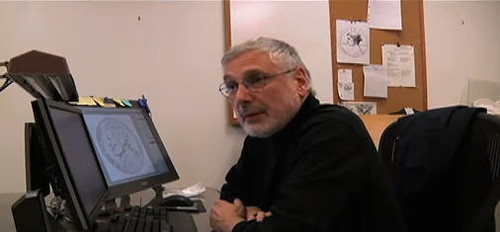
To visit the U.S. Mint YouTube channel, see: www.youtube.com/user/USMINT (www.youtube.com/user/USMINT)
MORE ON NUMISMATIC TERMINOLOGY
Tom DeLorey writes:
Regarding the best description of the "relief" on the Pratt $2-1/2 and $5, I have sometimes referred to it in print as "Recessed Relief," since it is in normal relief but recessed below the surface of the coin.
To read the complete article, see: PROPOSED NEW TERMS FOR A NUMISMATIC ENCYCLOPEDIA (www.coinbooks.org/esylum_v14n05a17.html)
THE BOOK BAZARRE
THE LASSER COLLECTION AT COLONIAL WILLIAMSBURG
 On January 17, 2011, the international numismatic community lost a titan with the passing of Joseph "Joe" Lasser. Far more than just a collector, Joe, with the support of his family, became a prominent scholar, author and philanthropist.
On January 17, 2011, the international numismatic community lost a titan with the passing of Joseph "Joe" Lasser. Far more than just a collector, Joe, with the support of his family, became a prominent scholar, author and philanthropist.
Joe's childhood fascination with things numismatic resurged as his young family matured, and he began to collect the paper money of the colonial period, including the Continental Currency issues of the Revolutionary War period. Always brilliant and inquisitive, it was in this area that Joe made his first significant contribution to numismatics. After painstakingly reading though tens of thousands of pages of Continental Congress papers, Joe assembled the universally accepted list of authorized Continental Currency signers which appears in Eric Newman's The Early Paper Money of America.
Shortly thereafter, Joe set out to collect anything and everything that circulated in colonial America, including coins of the world trade. Over the years, the Lasser collection grew in size and scope, and now contains world-class holdings of American colonial material. Areas of great strength include Betts and Indian peace medals, Massachusetts silver coins by die variety, and French, Dutch and Spanish Colonial coins. In the latter category, Joe's collection of Colombian coins formed the basis his The Cob Coinage of Colombia (2000), co-authored with Jorge Restrepo, and now the standard reference on the subject.
Other numismatic publications include The Coins of Colonial America (1997) in addition to some two dozen articles appearing in various publications over the past four decades. Further immersing himself into collecting and publishing, he began not only to lend coins & paper money to museum exhibits, but he began giving them to various North American institutions that had a use for them.
Joe never lost sight of how lucky he was, and his unique circumstances allowed him to assemble a collection few could even dream of doing. A lover of numismatics to the core, he was aware of the value of education, and thus his primary focus shifted from the acquisition or material to sharing it with those inside and outside of the numismatic community.
After a long and difficult search, and with the support of his family, Joe decided that this unique collection could be best "used," as he put it, by the Colonial Williamsburg Foundation. Today, the Foundation's multitude of ventures ranging from museum and virtual exhibitions to national educational programs, have found "uses" for the collection that go well beyond what Joe initially imagined. With more than 3600 coins, medals and pieces of paper money, the Lasser collection at Colonial Williamsburg is truly a national treasure.
To read the earlier E-Sylum article, see: JOSEPH R. LASSER 1923 - 2011 (www.coinbooks.org/esylum_v14n04a02.html)
MORE ON THE NUMISMATIC MUSEUM OF ATHENS
Howard Berlin writes:
In last week's E-Sylum, Alan Luedeking mentioned the Numismatic Museum of Athens. When I was in Athens several years ago after visiting Istanbul, I was given a guided tour of the museum by the curating staff and was given about half a dozen heavy books that put me over the baggage weight limit but British Airways didn't charge me. I wrote a World Destinations column for the January 2009 issue of Coin World's WorldWide Coins magazine.
Coin World editor Beth Deisher adds: "Worldwide Coins now is published monthly as the World Coins section of Coin World's Special Edition published the first issue of each month."
By the way, Howard's articles on museums in Athens, Dublin and Cologne won the Numismatic Literary Guild's 2009 award for best column for world commercial numismatic magazines. Congratulations!
-Editor
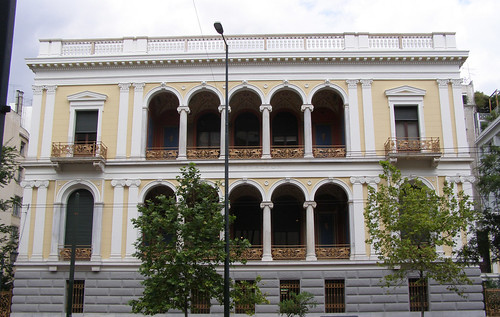
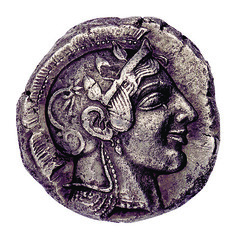 An ancient city is full of historically important sites. One must-visit location for collection is the National Museum of Athens with its extraordinary coin collection.
An ancient city is full of historically important sites. One must-visit location for collection is the National Museum of Athens with its extraordinary coin collection.
 The museum's seed collection began with 359 coins. There are now more than 600,000 coins, lead seals, medallions, precious stones and balance weights from ancient Greece, Rome and Byzantium, plus specimens dating from western Europe's Middle Ages to the present in the collection. About 2,500 coins are exhibited in more than 40 displays in rooms throughout the building's two floors.
The museum's seed collection began with 359 coins. There are now more than 600,000 coins, lead seals, medallions, precious stones and balance weights from ancient Greece, Rome and Byzantium, plus specimens dating from western Europe's Middle Ages to the present in the collection. About 2,500 coins are exhibited in more than 40 displays in rooms throughout the building's two floors.
To read the earlier E-Sylum article, see: THE NATIONAL NUMISMATIC MUSEUM OF GREECE (www.coinbooks.org/esylum_v14n05a14.html)
MORE ON NUMISMATIC E-BOOKS AND OUTREACH TO YOUNGER COLLECTORS
Regarding Scott Barman's discussion of e-books, Joe Boling rightly notes that
The problem with e-books is not being able to read them fifteen years from now because the original reading machine will have expired and the original source will not have kept up with new reading machine technology.
I would encourage all publishers of e-books to make a print-on-demand version available as well, and to donate both print and electronic copies to several major numismatic and non-numismatic libraries to ensure the long-term survival of the work.
Since he's just published a couple electronic works, I asked Roger Burdette if he'd considered making his books available on something like Lulu.com so people could make hardcopies if they want to. His take is that "the product quality is (in my opinion) low. Also, anything that makes the material dependent on a commercial enterprise is high risk."
Well, there is always the risk that the chosen print-on-demand provider will go out of business someday, but if some hardcopies are produced before that happens then at least the works will still exist in a book format that will likely outlive any given electronic format. The print quality may not be the best, but even a moderate quality physical book has some advantages over an ephemeral electronic version. Ultimately, this is a question for every author to grapple with. I did confirm with Roger however, that every buyer of his electronic books is free to print hardcopies of the files for their own use.
-Editor
Roger Burdette adds:
One of the key factors is including an ISBN for publications. This allows copies to be located, even if there are only a few in existance. As far as obsolete formats, that is a possibility; however, by using a "generic" format such as PDF and standard media (CD, DVD) that is in wide use, obsolescence is minimized. I'd also recommend depositing archive electronic and paper copies with some long-term institutions such as ANA or ANS or a major university.
Bill Rosenblum of Littleton, CO writes:
I understand where Scott Barman is going in his quest for more E-books (or whatever they are called). I know many (perhaps most) books and periodicals are now available both in print and "up there somewhere". My son Brian has been involved with this movement for 10+ years first at the University of Michigan, now at Kansas University. Technically he's explained it to me but it usually goes well over my head. But I don't think numismatic literature has to be available in one form in the other. It can be both.
However, I didn't know numismatics needed revitalizing in the first place. Numismatics is changing all the time but the hobby is very strong. I see quite a number of "young people" at shows and I'm guessing more than a few of my customers I "meet" via email are young.
To read the earlier E-Sylum article, see: COULD MORE E-BOOKS REVITALIZE NUMISMATIC HOBBY? (www.coinbooks.org/esylum_v14n05a15.html)
QUERY: EARLIEST "HOBO NICKEL" USE AND ILLUSTRATION SOUGHT
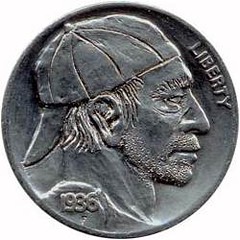 What is the earliest illustration of a hobo nickel in the numismatic literature (or any publication)? And what was the earliest published use of the name "hobo nickel?"
What is the earliest illustration of a hobo nickel in the numismatic literature (or any publication)? And what was the earliest published use of the name "hobo nickel?"
Several of my fellow Original Hobo Nickel Society members have wondered the answer to these questions. Thanks in advance.
To visit the Original Hobo Nickel Society web site, see: www.hobonickels.org ()
NOTES FROM E-SYLUM READERS: FEBRUARY 6, 2011
A U.S. Mint in Chicago?
Ginger Rapsus writes:
Was a U.S. Mint in Chicago ever planned, or even considered? Anyone know?
California Gold tokens
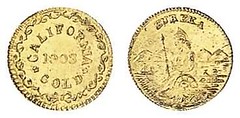
Tom DeLorey writes:
The Hirsh California gold token picture appears to be one side each of two different pieces in a lot of three different pieces. Illustrative minimalism at its finest.
The piece on the left is dated 1903, as is the third piece of the lot. I would guess that they are souvenir tokens sold at the 1904 St. Louis World's Fair, but that is just a guess. The Eureka design has been used on many souvenir tokens, and I have no guess as to its nature.
To read the complete lot description at the Gerhard Hirsh web site, see: 1/8 Dollar 1853 California Gold (www.coinhirsch.de/?cat=270-271&lot=4296)
Marshall Faintich on Prof. Weir's Article
I sent a link to Prof' Weir's article to Marshall Faintich, author of Astronomical Symbols on Ancient and Medieval Coins. He writes:
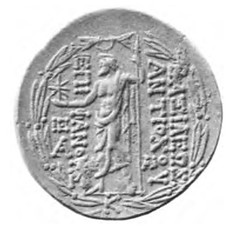 Thanks for sending me the article - I hadn't seen it before. This coin was not mentioned in my book. There are so many examples that I could not include all of them. And ancient examples are particularly difficult because the numismatic references showing all of the coins and their variations are not neatly contained in only a few books.
Thanks for sending me the article - I hadn't seen it before. This coin was not mentioned in my book. There are so many examples that I could not include all of them. And ancient examples are particularly difficult because the numismatic references showing all of the coins and their variations are not neatly contained in only a few books.
A Finder's Challenge Coin
An E-Sylum reader forward this article about the awarding of a Challenge Coin to a man who returned a found wallet.
An act of altruism earned a Knight alumnus token of high honor from the UCF Police Department on Jan. 20.
On January 19, anthropology graduate Matt Newton noticed an abandoned wallet and cell phone in the downstairs men's restroom of Howard Phillips Hall. Newton said he glanced around for the owner but didn't see anyone.
To Newton's surprise, the wallet contained more than $200 and several debit cards. Instead of going on a shopping spree, he turned it over to the UCF police.
Newton was awarded a UCF challenge coin, a token rewarded to those who perform an honorable act.
To read the complete article, see:
UCF alumnus awarded challenge coin
(www.centralfloridafuture.com/mobile/ucf-alumnus-
awarded-challenge-coin-1.2444163)
A Bibliophile's Chair
Stephen Pradier writes:
This is a real item for someone who lives in cramped quarters. What do E-Sylum readers think?
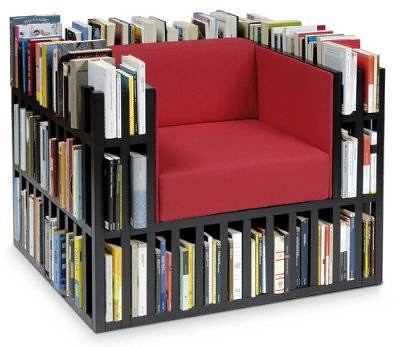
Penny Loafers Cost A Bundle
Finally, a note of humor from Dick Johnson:
Catalog received this week. Ralph Lauren penny loafers are $99. You furnish your own pennies. I like the colors: Bugatti Blue, Porsche Orange, Jaguar Green, Cognac, Sage Suede, and, oh yes, brown.
They bear the wearer's favorite sport word on the heel: POLO. Make mine read POGS.
NUMISMATIC BOOK MUTILATION AT THE LIBRARY OF CONGRESS
Your recent item about Thomas Lowry being caught altering a document at the National Archives reminded me of another archive called the Library of Congress (LOC) in Washington, DC.
The LOC is a huge resource of numismatic information and I spent almost two years of Saturday mornings (and some other days if my wife would allow me) there back in the early 1980s looking in old books for numismatic information about Southeast Asia. It was a slow search from A to Z and each Saturday I had to return the books back to the librarian and retrieve them the next Saturday. Some books were not available because someone else would check them out before me, so I had to wait a week or more to see them again.
One of the young librarians, Will Tuchrello, in the South Asia department (which has Southeast Asia), saw that I was a serious researcher and he found a desk for me in a "researchers" room so I did not have to be out in the reading room. I also had a place to store a heavy bag of nickels which I used at the copy machine. I could also keep my books on the desk until I finished with them. My research really sped up!
Once I completed what I could find in the card catalogue, Will told me about a "stacks pass," which allowed me to go down into the library and search the shelves myself! I do not think they are available to anyone anymore.
To make a long story short, I copied about 5,000 pages (at five cents each). Even if I found one page with one sentence in it, I copied it along with the title and copyright pages. The sad part was finding references with pages of interest to me very neatly cut out with a razor blade! I could not believe someone would do this!
Many years later, I started seeing some of the missing plate pages showing up in a numismatist's writings! I had no proof of his sources so I kept my mouth shut and copied that person's plate and sent a copy to the LOC for them to insert it into the original. I also copied them after I purchased an original book.
After a decade or two of copying the plates in that person's writings, I thanked him at a show for including the old plates and told him that I was copying them and sending them to the LOC so they could have a copy of them. His face turned as white as a sheet! He did not admit anything but he kept his distance from me at future shows and conventions.
There are people out there who do not have any feelings at all about destroying valuable references for their own convenience. He could have just as easily copied the pages like I did but he chose to cut them out of the book and take them out of the library! I am very happy to report there are only a few of these cancers among us. This man passed away a couple of years ago.
But I am happy to report that Dr. Tuchrello was promoted up through the ranks and is now the Director of the LOC's Southeast Asia office in Jakarta, Indonesia. He travels the region looking for references, posters, maps, etc. to purchase to send back to the LOC. The LOC also trades American publications with countries too! The LOC could not have found a more dedicated person for the job!
To read the earlier E-Sylum article, see: HISTORIAN ACCUSED OF ALTERING LINCOLN DOCUMENT AT NATIONAL ARCHIVES (www.coinbooks.org/esylum_v14n05a21.html)
THE PROFESSIONAL EDITION RED BOOK IS HERE!
LOOTING IN EGYPT: WHAT NEXT?
From Coins Weekly:
On the verge of the demonstrations at the Tahrir square in Cairo Egyptian cultural property has become a victim of looters. Last Friday, during the night of January 28, unknown persons have broken into the Egyptian Museum in Cairo. Right now, nobody really knows, what has been damaged, destroyed or stolen.
To read the complete article, see: Looting at the Egyptian Museum in Cairo and at other remote excavations (www.coinsweekly.com/en/page/4?&id=428)
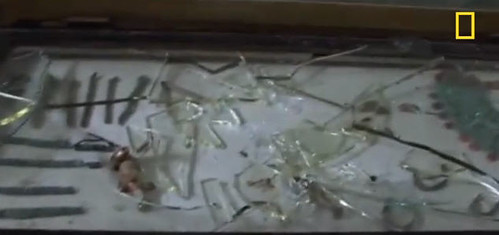
To view the National Geographic YouTube video, see: Egypt Antiquities Damaged, at Risk During Unrest (www.youtube.com/watch?v=GICGdVS-jck)

To read the earlier E-Sylum article, see: EGYPT FINDS HOARD OF 2,000-YEAR-OLD BRONZE COINS (www.coinbooks.org/esylum_v13n17a26.html)
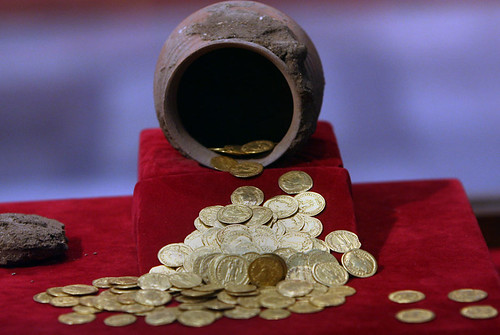
To read the earlier E-Sylum article, see: EGYPTIAN MUSEUM EXHIBIT: COINS THROUGH THE AGES (www.coinbooks.org/esylum_v13n33a19.html)
QUERY: 1872 COIN HOARD FIND SOUGHT
Around his neck he wears the prized piece of his antique coin collection; a gold Portuguese escudo (coin), which he has fashioned onto a heavy, silver chain. The coin bears the date 1746 and the likeness of King John V of Portugal, who reigned from 1706 until his death in 1750. Other markings on the coin indicate it was minted in Brazil.
Shortly after discovering it on the beach in Cape May, part-time treasure hunter Fred Croasdale consulted a rare coins expert at the Sotheby's auction house in New York and was told that his find was valued at approximately $2,000. That was much less than it would have been had it been minted in Portugal during that time. Nevertheless, Croasdale is proud of this and many of his discoveries.
"I screamed like a little kid when I found it," he said.
Currently, Croasdale is waiting for dredging to cease off the cove in Cape May so he can see what valuables the sea offers. When asked what his dream discovery would be, Croasdale is quick to mention the long-rumored buried treasure of the infamous Capt. Kidd.
Tales of Kidd's treasure at Cape May Point have tantalized local residents and treasure hunters for centuries. Croasdale also cites other such treasure that has already been discovered.
"I know for a fact," said Croasdale, "that in 1872 they were digging a ditch at Dick Thompson's farm in Cold Spring and they pulled up a chest with $30,000 in silver and gold coins that dated from the 1600s. There have been many small caches of gold coins found. There's plenty out there. There's always stuff to be found."
To read the complete article, see:
Treasures don't always stay buried
(www.shorenewstoday.com/index.php/regional/
cape-may-county/8149-treasures-dont-always-stay-buried.html#)
SPAIN'S NEW 2011 TWO-EURO COIN
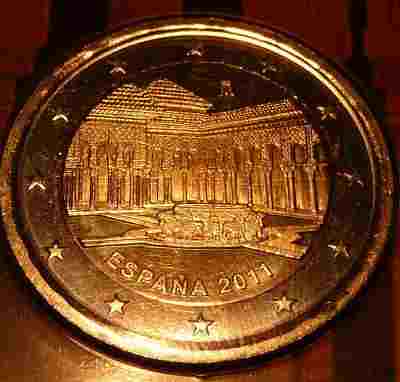
I posted my query to the NBS Facebook page, and quickly received an answer. Thanks! Mathew Baca writes:
Court of the Lions in the Alhambra
Martin Purdy writes:
I'll second that - a photograph of the court taken in 1934 was posted today at the worldofcoins.eu forum by way of confirmation.

TWO ALASKAN MEDALS IN CERAMIC OR PORCELAIN
Alaska Yukon-Pacific Exposition Medal
1959 Alaska Statehood medal
In the May 2008 issue Phil Iverson presented two ceramic or porcelain medals for our examination. One was the AYPE medal which was white on blue. The other was a 1959 Alaska Statehood medal. This one was grayish white on black.
Recently on eBay an example of the AYPE medal was offered for sale. As far as I could tell, it was identical to Phil's piece, including the MB on the reverse. It was called "Jasperware."
Jasperware was developed by Josiah Wedgwood. In searching eBay for other examples, the white seems whiter and the boundaries between the two colors seem more distinct. The markings on the back do not indicate Wedgwood, so I doubt that this is Jasperware. It is, for lack of a better term, an interesting imitation. Price Realized - $152.50.
MANLEY SELLS MENTOR'S ORANGE COUNTY NATIONAL BANK NOTES
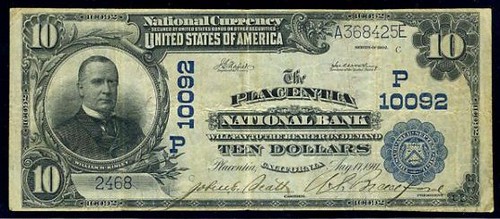
In 1882, having a $10 bill was like having $215 or so now.
But having an 1882 $10 bank note – or at least one issued by the First National Bank of Fullerton – is like having $10,063 today. That is what the note sold for.
The Fullerton bank note was among a collection of old Orange County ones offered up at auction this week in Beverly Hills. One of the most-expensive items was a La Habra note that sold for $15,525.
Most of the notes are from north Orange County, issued by banks in Garden Grove, Anaheim, Fullerton and Santa Ana.
The notes were in the private collection of William Pannier, a Fullerton rare-coin dealer and collector. Pannier owned Fullerton Coin & Stamps from 1976 until his death last August.
Pannier, raised in Anaheim, had been collecting paper money since the 1960s with a particular interest in old local currencies. His Orange County collection was sold as part of his shop to sports agent Dwight Manley, who worked in the shop as a teenager.
Manley said he put the bank notes up for auction because he personally only collects Brea notes.
To read the complete article, see: Old O.C. notes fetch a pretty penny (www.ocregister.com/articles/fullerton-287029-bill-pannier.html)
FAKE 1804 DOLLAR DROPPED IN SALVATION ARMY KETTLE
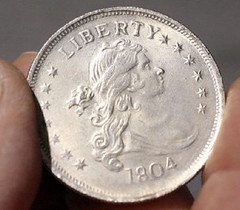 He tried not to get his hopes up, but Salvation Army Whittier Corps Maj. Charles Gillies couldn't help it.
He tried not to get his hopes up, but Salvation Army Whittier Corps Maj. Charles Gillies couldn't help it.
You couldn't blame him for imagining what good deeds his nonprofit charity could do with a potentially valuable 1804 silver dollar coin. It was discovered among the thousands people plunked into the local Salvation Army's kettles over the Christmas holiday.
"We have a hillside behind our emergency shelter that could be expanded with a new retaining wall, along with new landscaping to fit the area," Gillies said Thursday inside the Long Beach Convention Center, where the Long Beach Coin, Stamp & Collectibles Expo was being held.
After taking the coin to an expert appraiser at the show, , Gillies was told - rather quickly - that his coin was in fact a fake.
Had it been real, it could have fetched anywhere from $4 million to $6 million, the experts said.
"I expected it would be," said Gillies, who was only slightly disappointed. "I mean, how weird that would have been - that an authentic coin worth millions of dollars would end up at the bottom of one of our kettles? It's what I was expecting.
"But I was still hoping," he quickly added, grinning.
To read the complete article, see: 1804 coin found in Salvation Army kettle found to be a fake (www.whittierdailynews.com/news/ci_17287221)
FEATURED WEB PAGE: TEACHING COINS
This week's Featured Web Page is the Teaching Coins page from the U.K.'s Token Corresponding Society web site.
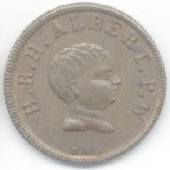
Albert, Prince of Wales - later Edward VII
These were issued to, or used by, schools from 1843 onwards to help children learn £.s.d. (pounds, shillings and pence) and to generally assist in learning to count money. From 1843 the coins were made in various metals - to match the currency - until the late 1800's. Then cardboard was used and these resembled the coins actually in use. This carried on until the late 1900's.
Running alongside the cardboard from about the 1970's is a vast series of decimal coins in plastic, only some of which are "educational" with most being issued, by many manufacturers, for games and toys. [Plastic coins and tokens are also covered by a separate topic.]
TEACHING COINS IN METAL.
S. G. ONIONS. "GET TO KNOW YOUR ONIONS"
S. G. Onions produced a series of coins in 1843 for educational purposes - for teaching in schools and at home. It is an extremely rare series as most were lost by use and they are now over 160 years old. There are 10 main denominations from "1 SOVEREIGN IS 1 POUND" down to "4 FARTHINGS MAKE 1 PENNY". The portrait is always of the baby PRINCE ALBERT, PRINCE OF WALES (later King Edward VII) and each reverse has the correct number of dots for the denomination to help with counting. For example, "12 PENCE MAKE 1 SHILLING" has 12 dots. This is the coin most usually seen but is still rare. All the other denominations are very rare indeed. The coins range from only 11mm diameter to 17mm diameter. A variety of metals were used but the base metal is usually either copper or brass. The set was reputed to have been issued in a wire mesh bag but none seem to be known today.
www.tokensociety.org.uk/topics/teaching.shtml
